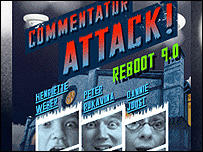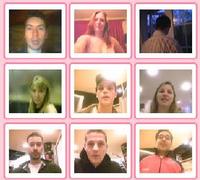| Wednesday, June 6, 2007 |
| Natural organization |
 Robert Paterson: Robert Paterson:I am on quest - a quest to find the reality of a way of organizing people so that we can become the most that we can be. My ingoing thesis is that humans must have a way of organizing that is natural. After all acorns, whales, stars and winds do.I'm with you on that. Me too. Robert gave one of my favorite presentations at Reboot. Slides here. One of the things he talked about was what could be learned from the organization of Roman legions. An organizational structure that worked very well for a great many years. This core organization is about 5,000 people. It has inside of it, all the capability to do any work.The numbers are important. The base organizational work unit has 80 people in it. Depending on the task of the time, these were sometimes doubled up into a work group with 160 people. When a big job had to be done, 6 of the base groups would be assembled into a work group of about 480 people. This 480 person grouping was ideal for complex work of all types. Such a group could also be separated from the main body by thousands of miles and by years and still hold its cohesion.So, apprently the numbers end up forming something similar to a Fibonacci sequence, representing some numbers that just naturally work well, and that add up in a certain way. This organization is in reality a network of social building blocks of 1 - 2 - 8 - 80 - 160 - 480 - 5,000 - 150,000.The point is that there are certain sizes of groups that work better than others. There are limits to how many people one can have a relation to at the same time. Like the 150 of Dunbar's Number. There are other key factors than the numbers, of course. Factors that make people very close, like living in the same tent with the same group for 20 years. And how the leaders are selected. I wouldn't have thought of Roman legions as being an example of natural organization. But it makes sense that when one evolves organizations that work very well, one is likely to have stumbled upon some principles of nature that just work. [ Organization / reboot9 | 2007-06-06 22:55 | 2 comments | PermaLink ] More > |
| Monday, June 4, 2007 |
| Rebooting the Web 2.0 age |

Nice writeup at BBC about Reboot by Jem Stone, who was one of the participants: The future of the web is being debated at Reboot 9.0, a leading European grassroots technology and design conference in Copenhagen. [ Information / reboot9 | 2007-06-04 15:50 | 0 comments | PermaLink ] |
| Sunday, June 3, 2007 |
| Flow |
| How does one best capture what one can take away from a lecture? One can just somehow process it and internally organize it as one hears it, I suppose. Or one can count on being able to watch the video later. Or one can take notes. But how? I unfortunately missed Stowe Boyd's talk on Flow, a new consciousness for a web of traffic, in order to be in a conversation about owning one's learning path. But Lars Plougmann made his notes in the form of a nice mind map, which you can see below. And when Stowe puts up his slides, I guess I can piece the point together. Mind maps is a good way of keeping notes.
[...Later] Video of Stowe's presentation here. [ Information / reboot9 | 2007-06-03 15:35 | 2 comments | PermaLink ] More > |
| Monday, May 28, 2007 |
| Owning your learning path |
 Picking from some of the interest presentations and discussions coming up at reboot, Ton Zylstra and Elmine Wijnia will focus on tools for owning your learning path. Picking from some of the interest presentations and discussions coming up at reboot, Ton Zylstra and Elmine Wijnia will focus on tools for owning your learning path.What does it take to be the owner of your own learning path, so that you can reach your goals?I like that. Are there really any good tools that support learning in life? For that matter, are there any good tools for supporting ongoing progress and development in some area, or in several areas at the same time? There's project management software if you have a specific business project with targets and deadlines. There are systems for staying organized. Many systems for recording stuff, like blogs and wikis. There are ways of scheduling things, like, of course calendars. But learning? There is course software, for presenting lessons and doing tests and that kind of thing. But for learning in life? I can't think of anything, so that's a great thing to work on. [ Knowledge / reboot9 | 2007-05-28 22:15 | 1 comment | PermaLink ] More > |
| Ambient intimacy |
 Another reboot subject, Ambient intimacy, with Leisa Reichelt: Another reboot subject, Ambient intimacy, with Leisa Reichelt: 'Ambient Intimacy' is a term I coined recently to describe an ancient effect which has come to the fore with the use of technologies such as Flickr and Twitter. Evan Williams of Obvious (creators of Twitter) recently used this term at the International Conference of Weblogs & Social Media to explain the value that Twitter offers it's users.Excellent term. So, yes, Japanese teenage cellphone users, that's a good example. I forgot the numbers, but it is a surprisingly huge amount of SMSes they exchange every day on the average. With a cellphone, you can be in touch with your pals all the time, and you can coordinate all your activities, if you so wish, and keep each other informed. You can move around town, and organize impromptu meetings, and you no longer need so much of a schedule or planned meeting times and places. I haven't gotten into the twitter thing. For those who don't know, it is essentially that you receive SMSes that tell you little things your friends are doing. What they're eating for lunch, what they're watching on TV, what they're thinking about, or whatever else they'd want to share. I don't know, I think I'd find that a little annoying to receive as SMS. I like the idea that it is visible, though. Not all types of media are practical for this. Push media like e-mail or SMS or phone calls easily become annoying. I don't want to be contacted and interrupted to be told what somebody's having for breakfast, as I'll probably be asleep. What I wouldn't mind having would be a device that started me off with a global picture of where everybody I know are, and where I very easily could zoom in and see more. So, a global picture first, and then the detail. Doesn't have to start with location. It could be, ok, here's a graphic of what state these 50 people you care about are in. 5 are in meetings, 10 are sleeping, 15 are eating, 10 are commuting, 10 are hidden. And I can then look closer and see what else they're sharing. Within certain limits, I wouldn't necessarily mind having a webcam on top of my head so I could share what I was doing. I wouldn't leave it on all the time, but a good deal of time, I wouldn't mind. I wouldn't mind a GPS in my pocket that shared my position. Most of the time I wouldn't mind sharing info about what I'm doing. Automated and effortless systems for some of that could replace some of what blogging is about, and also turn it into something else. I probably wouldn't want to share all of it with just anybody, but there will always be people I'd happily let know most of what I do. Things like that will inevitably happen, as the technologies become available. At the same time we'll need better ways of being selective about what we want and don't want to share, and with who. [ Culture / reboot9 | 2007-05-28 22:46 | 2 comments | PermaLink ] More > |